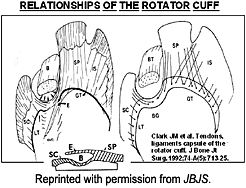All of us using Graston Technique®, ART®, friction massage and neuromuscular rehabilitation, are treating the insertion of the supraspinatus as it inserts into the greater tuberosity of the shoulder.
The rotator cuff forms a solid sleeve of fibrous tissue that surrounds the proximal end of the humerus. Notice how the SP and infraspinatus (IS) first blend together about an inch before they insert into the greater tuberosity (GT). What is important from the standpoint of manual treatment is that the SP and IS interdigitate. Therefore, it is important when treating the IS insertion that we also include the SP insertion, and that when we treat the SP insertion, we include some of the IS.
Notice that the SP joins the subscapularis (SC) insertion (LT - lesser tuberosity), forming a sheath or floor beneath the proximal biceps tendon (BT). BG is the bicipital groove. The subscapularis therefore extends from the lesser tuberosity beneath the biceps to join the SP. Not only does the supraspinatus form a floor for the biceps, but there is also an extension of the supraspinatus (E) that forms a roof over the biceps. What is not shown is the coracohumeral ligament, which is superficial to the shoulder capsule and also overlies the biceps tendon, and has branches that envelop the superficial and deep portions of the supraspinatus.
From the standpoint of treating the rotator cuff, it is apparent that all of the cuff muscles form a continuous insertion on the humerus. Absolute specificity on a particular insertion point is no longer warranted. Treatment of the infraspinatus insertion should include part of the supraspinatus. Treatment of the supraspinatus insertion should include the biceps tendon. It was always taught to treat the subscapularis insertion directly on the hard lesser tuberosity. Treatment of the SC must now include the proximal biceps in the bicipital groove.
This approach to adjoining areas must be added to the variety of soft tissue techniques now in use.
Warren Hammer, MS, DC, DABCO
Norwalk, Connecticut
www.warrenhammer.com
Click here for previous articles by Warren Hammer, MS, DC, DABCO.






